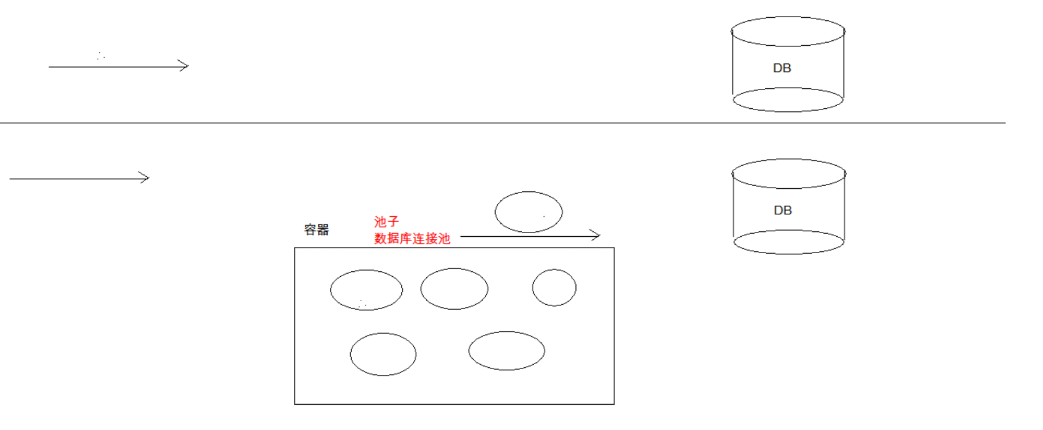大纲
1. 数据库连接池
2. Spring JDBC : JDBC Template

数据库连接池
1. 概念:其实就是一个容器(集合),存放数据库连接的容器。
当系统初始化好后,容器被创建,容器中会申请一些连接对象,当用户来访问数据库时,从容器中获取连接对象,用户访问完之后,会将连接对象归还给容器。
2. 好处:
1. 节约资源
2. 用户访问高效
3. 实现:
1. 标准接口:DataSource javax.sql包下的
1. 方法:
* 获取连接:getConnection()
* 归还连接:Connection.close()。如果连接对象Connection是从连接池中获取的,那么调用Connection.close()方法,则不会再关闭连接了。而是归还连接
2. 一般我们不去实现它,有数据库厂商来实现
1. C3P0:数据库连接池技术
2. Druid:数据库连接池实现技术,由阿里巴巴提供的
4. C3P0:数据库连接池技术
* 步骤:
1. 导入jar包 (两个) c3p0-0.9.5.2.jar mchange-commons-java-0.2.12.jar ,
* 不要忘记导入数据库驱动jar包
2. 定义配置文件:
* 名称: c3p0.properties 或者 c3p0-config.xml
* 路径:直接将文件放在src目录下即可。
3. 创建核心对象 数据库连接池对象 ComboPooledDataSource
4. 获取连接: getConnection
* 代码:
//1.创建数据库连接池对象
DataSource ds = new ComboPooledDataSource();
//2. 获取连接对象
Connection conn = ds.getConnection();
5. Druid:数据库连接池实现技术,由阿里巴巴提供的
1. 步骤:
1. 导入jar包 druid-1.0.9.jar
2. 定义配置文件:
* 是properties形式的
* 可以叫任意名称,可以放在任意目录下
3. 加载配置文件。Properties
4. 获取数据库连接池对象:通过工厂来来获取 DruidDataSourceFactory
5. 获取连接:getConnection
* 代码:
//3.加载配置文件
Properties pro = new Properties();
InputStream is = DruidDemo.class.getClassLoader().getResourceAsStream("druid.properties");
pro.load(is);
//4.获取连接池对象
DataSource ds = DruidDataSourceFactory.createDataSource(pro);
//5.获取连接
Connection conn = ds.getConnection();
2. 定义工具类
1. 定义一个类 JDBCUtils
2. 提供静态代码块加载配置文件,初始化连接池对象
3. 提供方法
1. 获取连接方法:通过数据库连接池获取连接
2. 释放资源
3. 获取连接池的方法
* 代码:
public class JDBCUtils {
//1.定义成员变量 DataSource
private static DataSource ds ;
static{
try {
//1.加载配置文件
Properties pro = new Properties();
pro.load(JDBCUtils.class.getClassLoader().getResourceAsStream("druid.properties"));
//2.获取DataSource
ds = DruidDataSourceFactory.createDataSource(pro);
} catch (IOException e) {
e.printStackTrace();
} catch (Exception e) {
e.printStackTrace();
}
}
/**
* 获取连接
*/
public static Connection getConnection() throws SQLException {
return ds.getConnection();
}
/**
* 释放资源
*/
public static void close(Statement stmt,Connection conn){
/* if(stmt != null){
try {
stmt.close();
} catch (SQLException e) {
e.printStackTrace();
}
}
if(conn != null){
try {
conn.close();//归还连接
} catch (SQLException e) {
e.printStackTrace();
}
}*/
close(null,stmt,conn);
}
public static void close(ResultSet rs , Statement stmt, Connection conn){
if(rs != null){
try {
rs.close();
} catch (SQLException e) {
e.printStackTrace();
}
}
if(stmt != null){
try {
stmt.close();
} catch (SQLException e) {
e.printStackTrace();
}
}
if(conn != null){
try {
conn.close();//归还连接
} catch (SQLException e) {
e.printStackTrace();
}
}
}
/**
* 获取连接池方法
*/
public static DataSource getDataSource(){
return ds;
}
}
Spring JDBC
* Spring框架对JDBC的简单封装。提供了一个JDBCTemplate对象简化JDBC的开发
* 步骤:
1. 导入jar包

2. 创建JdbcTemplate对象。依赖于数据源DataSource
* JdbcTemplate template = new JdbcTemplate(ds);
3. 调用JdbcTemplate的方法来完成CRUD的操作
* update():执行DML语句。增、删、改语句
* queryForMap():查询结果将结果集封装为map集合,将列名作为key,将值作为value 将这条记录封装为一个map集合
* 注意:这个方法查询的结果集长度只能是1
* queryForList():查询结果将结果集封装为list集合
* 注意:将每一条记录封装为一个Map集合,再将Map集合装载到List集合中
* query():查询结果,将结果封装为JavaBean对象
* query的参数:RowMapper
* 一般我们使用BeanPropertyRowMapper实现类。可以完成数据到JavaBean的自动封装
* new BeanPropertyRowMapper<类型>(类型.class)
* 格式:template.query(String sql,new BeanPropertyRowMapper<类型>(类型.class));
例:List<User> users = template.query(sql, new BeanPropertyRowMapper<User>(User.class));
* queryForObject:查询结果,将结果封装为对象
* 一般用于聚合函数的查询
4. 练习:
* 需求:
1. 修改1号数据的 salary 为 10000
2. 添加一条记录
3. 删除刚才添加的记录
4. 查询id为1的记录,将其封装为Map集合
5. 查询所有记录,将其封装为List
6. 查询所有记录,将其封装为Emp对象的List集合
7. 查询总记录数
* 代码:
import cn.itcast.domain.Emp;
import cn.itcast.utils.JDBCUtils;
import org.junit.Test;
import org.springframework.jdbc.core.BeanPropertyRowMapper;
import org.springframework.jdbc.core.JdbcTemplate;
import org.springframework.jdbc.core.RowMapper;
import java.sql.Date;
import java.sql.ResultSet;
import java.sql.SQLException;
import java.util.List;
import java.util.Map;
public class JdbcTemplateDemo2 {
//Junit单元测试,可以让方法独立执行
//1. 获取JDBCTemplate对象
private JdbcTemplate template = new JdbcTemplate(JDBCUtils.getDataSource());
/**
* 1. 修改1号数据的 salary 为 10000
*/
@Test
public void test1(){
//2. 定义sql
String sql = "update emp set salary = 10000 where id = 1001";
//3. 执行sql
int count = template.update(sql);
System.out.println(count);
}
/**
* 2. 添加一条记录
*/
@Test
public void test2(){
String sql = "insert into emp(id,ename,dept_id) values(?,?,?)";
int count = template.update(sql, 1015, "郭靖", 10);
System.out.println(count);
}
/**
* 3.删除刚才添加的记录
*/
@Test
public void test3(){
String sql = "delete from emp where id = ?";
int count = template.update(sql, 1015);
System.out.println(count);
}
/**
* 4.查询id为1001的记录,将其封装为Map集合
* 注意:这个方法查询的结果集长度只能是1
*/
@Test
public void test4(){
String sql = "select * from emp where id = ? or id = ?";
Map<String, Object> map = template.queryForMap(sql, 1001,1002);
System.out.println(map);
//{id=1001, ename=孙悟空, job_id=4, mgr=1004, joindate=2000-12-17, salary=10000.00, bonus=null, dept_id=20}
}
/**
* 5. 查询所有记录,将其封装为List
*/
@Test
public void test5(){
String sql = "select * from emp";
List<Map<String, Object>> list = template.queryForList(sql);
for (Map<String, Object> stringObjectMap : list) {
System.out.println(stringObjectMap);
}
}
/**
* 6. 查询所有记录,将其封装为Emp对象的List集合
*/
@Test
public void test6(){
String sql = "select * from emp";
List<Emp> list = template.query(sql, new RowMapper<Emp>() {
@Override
public Emp mapRow(ResultSet rs, int i) throws SQLException {
Emp emp = new Emp();
int id = rs.getInt("id");
String ename = rs.getString("ename");
int job_id = rs.getInt("job_id");
int mgr = rs.getInt("mgr");
Date joindate = rs.getDate("joindate");
double salary = rs.getDouble("salary");
double bonus = rs.getDouble("bonus");
int dept_id = rs.getInt("dept_id");
emp.setId(id);
emp.setEname(ename);
emp.setJob_id(job_id);
emp.setMgr(mgr);
emp.setJoindate(joindate);
emp.setSalary(salary);
emp.setBonus(bonus);
emp.setDept_id(dept_id);
return emp;
}
});
for (Emp emp : list) {
System.out.println(emp);
}
}
/**
* 6. 查询所有记录,将其封装为Emp对象的List集合
*/
@Test
public void test6_2(){
String sql = "select * from emp";
List<Emp> list = template.query(sql, new BeanPropertyRowMapper<Emp>(Emp.class));
for (Emp emp : list) {
System.out.println(emp);
}
}
/**
* 7. 查询总记录数
*/
@Test
public void test7(){
String sql = "select count(id) from emp";
Long total = template.queryForObject(sql, Long.class);
System.out.println(total);
}
}

